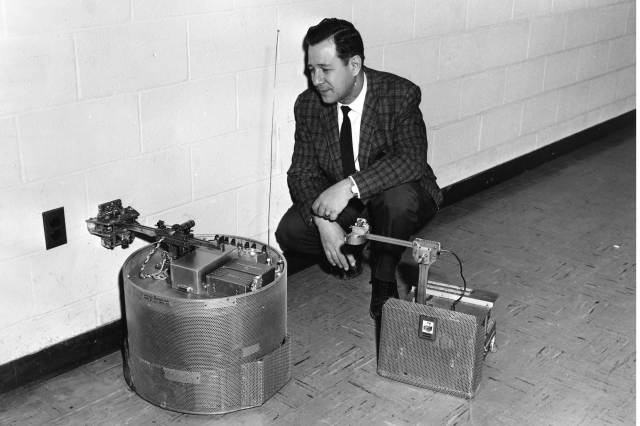JOHNS HOPKINS APL TECHNICAL DIGEST, VOLUME 24, NUMBER 1 (2003) p59
APL has had a distinguished history in decision support and situational awareness. For example, during the 1950s and 1960s, the Laboratory was critically engaged in the development of weapon control systems and the Navy Tactical Data System (NTDS), and performed the first experiments on commanders’ use of automated decision support systems. Researchers also began exploring mobile automata, developing two robots affectionately known as Ferdinand and the Hopkins Beast. Ferdinand and the Beast demonstrated primitive situational awareness as they roamed the halls of APL, avoiding obstacles, stairs, and open doorways, and accurately locating and attaching to electrical outlets to recharge their batteries. Significantly, these devices presaged ideas becoming popular today. For example, a feature of the Army’s Future Combat Systems program is the planned use of small robotic devices that will roam the battlefield to collect information and support combat operations.
In below Video clip, see 1min 46 sec in for 1 min 5 seconds. Following that in the same clip is the later 'Beast' Mod II.
Update: July 2013 – Johns Hopkins Applied Physics Lab published a videoclip (above) showing Ferdinand.
Ferdinand, the Mobile Automaton.
Close-up of Ferdinand's head-assembly.
Having located the outlet (the lower one of the two), Ferdinand recharges its batteries before moving on.

Leonard Scheer with Mod II (Beast) on the left, and Mod I (Ferdinand) on the right. Both automatons sought mains power outlets when their batteries ran low. The object on the side of Mod I's mesh is actualy his APL Visitor badge!
See later models here
 1962-3- APL-JHU Hopkins "Beast" Mod II pre-vision
1962-3- APL-JHU Hopkins "Beast" Mod II pre-vision


Type : Still Image
Title : Automaton 1 & II
Publisher : Johns Hopkins University. Applied Physics Laboratory (APL)
Date : 2/12/1965
Place of Publication : Applied Physics Laboratory, The Johns Hopkins University, 8621 Georgia Avenue, [Baltimore, Md., U.S.}
Identifying Numbers : other number 66196 ; other number P4614
Dimensions : 8 1/8 x 10 in.
Copyright Holder : Johns Hopkins University. Applied Physics Laboratory (APL)
Description
B&W. Number "66196" verso center left in ballpoint black ink, date "Feb 12 1965" verso lower left, address stamp verso left center, "P4614" pencil on verso lower right, ""The Beast" 1965" in broad black ink verso lower left. "Beast" in pencil verso upper right. Photo of two robots, each with a single arm, in a bare room with white walls and a tile floor.

Type : Still Image
Title : Automaton II with two Men
Publisher : Johns Hopkins University. Applied Physics Laboratory (APL)
Date : 8/17/1964
Place of Publication : Applied Physics Laboratory, The Johns Hopkins University, 8621 Georgia Avenue, [Baltimore, Md., U.S.}
Identifying Numbers : other number 66198 ; other number P4616
Dimensions : 8 1/8 x 10 in.
Copyright Holder : Johns Hopkins University. Applied Physics Laboratory (APL)
Description : B&W. Label once taped to verso (bottom center) has fallen off, number "66198" verso center right, date "Aug 17 1964" verso upper right, address stamp verso right center, "P4616" pencil on verso upper left, "The Beast" in pencil verso upper right. Fallen label text "John Chubbuck, foreground, with more recently developed automaton II, and Leonard Scheer, rear, with early model, developed three years ago."
Photo of two kneeling men, each next to a robot in a bare room with white walls and a tile floor.
RH Notes: First reference to earlier automaton being built 3 years earlier ie 1961, hence this post dated 1961.
A later post on Ferdinand's younger brother, Beast (or Mod II) describes the families raison d'etre. There was also a third model built based on artificial neurons. Mod IV was to be an underwater autonomous robot.
 1962-5- APL-JHU Hopkins "Beast" Mod II with extended sonar & vision
1962-5- APL-JHU Hopkins "Beast" Mod II with extended sonar & vision
One Reply to “1961 – Ferdinand Autonomous Robot Mod I – JHU APL (American)”
Comments are closed.